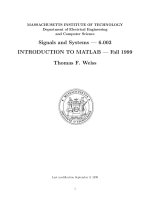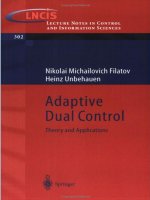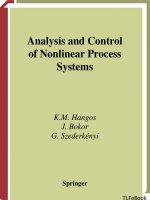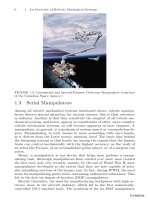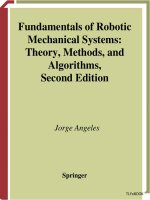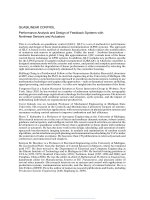Nonlinear Model Predictive Control: Theory and Algorithms (repost)
Bạn đang xem bản rút gọn của tài liệu. Xem và tải ngay bản đầy đủ của tài liệu tại đây (3.37 MB, 372 trang )
Communications and Control Engineering
For other titles published in this series, go to
www.springer.com/series/61Series Editors
A. Isidori
J.H. van Schuppen
E.D. Sontag
M. Thoma
M. Krstic
Published titles include:
Stability and Stabilization of Infinite Dimensional
Systems with Applications
Zheng-Hua Luo, Bao-Zhu Guo and Omer Morgul
Nonsmooth Mechanics (Second edition)
Bernard Brogliato
Nonlinear Control Systems II
Alberto Isidori
L
2
-Gain and Passivity Techniques in Nonlinear Control
Arjan van der Schaft
Control of Linear Systems with Regulation and Input
Constraints
Ali Saberi, Anton A. Stoorvogel and Peddapullaiah
Sannuti
Robust and
H
∞
Control
Ben M. Chen
Computer Controlled Systems
Efim N. Rosenwasser and Bernhard P. Lampe
Control of Complex and Uncertain Systems
Stanislav V. Emelyanov and Sergey K. Korovin
Robust Control Design Using
H
∞
Methods
Ian R. Petersen, Valery A. Ugrinovski and
Andrey V. Savkin
Model Reduction for Control System Design
Goro Obinata and Brian D.O. Anderson
Control Theory for Linear Systems
Harry L. Trentelman, Anton Stoorvogel and Malo Hautus
Functional Adaptive Control
Simon G. Fabri and Visakan Kadirkamanathan
Positive 1D and 2D Systems
Tadeusz Kaczorek
Identification and Control Using Volterra Models
Francis J. Doyle III, Ronald K. Pearson and Babatunde
A. Ogunnaike
Non-linear Control for Underactuated Mechanical
Systems
Isabelle Fantoni and Rogelio Lozano
Robust Control (Second edition)
Jürgen Ackermann
Flow Control by Feedback
Ole Morten Aamo and Miroslav Krstic
Learning and Generalization (Second edition)
Mathukumalli Vidyasagar
Constrained Control and Estimation
Graham C. Goodwin, Maria M. Seron and
José A. De Doná
Randomized Algorithms for Analysis and Control
of Uncertain Systems
Roberto Tempo, Giuseppe Calafiore and Fabrizio
Dabbene
Switched Linear Systems
Zhendong Sun and Shuzhi S. Ge
Subspace Methods for System Identification
Tohru Katayama
Digital Control Systems
Ioan D. Landau and Gianluca Zito
Multivariable Computer-controlled Systems
Efim N. Rosenwasser and Bernhard P. Lampe
Dissipative Systems Analysis and Control
(Second edition)
Bernard Brogliato, Rogelio Lozano, Bernhard Maschke
and Olav Egeland
Algebraic Methods for Nonlinear Control Systems
Giuseppe Conte, Claude H. Moog and Anna M. Perdon
Polynomial and Rational Matrices
Tadeusz Kaczorek
Simulation-based Algorithms for Markov Decision
Processes
Hyeong Soo Chang, Michael C. Fu, Jiaqiao Hu and
Steven I. Marcus
Iterative Learning Control
Hyo-Sung Ahn, Kevin L. Moore and YangQuan Chen
Distributed Consensus in Multi-vehicle Cooperative
Control
Wei Ren and Randal W. Beard
Control of Singular Systems with Random Abrupt
Changes
El-Kébir Boukas
Nonlinear and Adaptive Control with Applications
Alessandro Astolfi, Dimitrios Karagiannis and Romeo
Ortega
Stabilization, Optimal and Robust Control
Aziz Belmiloudi
Control of Nonlinear Dynamical Systems
Felix L. Chernous’ko, Igor M. Ananievski and Sergey
A. Reshmin
Periodic Systems
Sergio Bittanti and Patrizio Colaneri
Discontinuous Systems
Yury V. Orlov
Constructions of Strict Lyapunov Functions
Michael Malisoff and Frédéric Mazenc
Controlling Chaos
Huaguang Zhang, Derong Liu and Zhiliang Wang
Stabilization of Navier–Stokes Flows
Viorel Barbu
Distributed Control of Multi-agent Networks
Wei Ren and Yongcan Cao
Lars Grüne
Jürgen Pannek
Nonlinear Model
Predictive Control
Theory and Algorithms
Lars Grüne
Mathematisches Institut
Universität Bayreuth
Bayreuth 95440
Germany
Jürgen Pannek
Mathematisches Institut
Universität Bayreuth
Bayreuth 95440
Germany
ISSN 0178-5354
ISBN 978-0-85729-500-2 e-ISBN 978-0-85729-501-9
DOI 10.1007/978-0-85729-501-9
Springer London Dordrecht Heidelberg New York
British Library Cataloguing in Publication Data
A catalogue record for this book is available from the British Library
Library of Congress Control Number: 2011926502
Mathematics Subject Classification (2010): 93-02, 92C10, 93D15, 49M37
© Springer-Verlag London Limited 2011
Apart from any fair dealing for the purposes of research or private study, or criticism or review, as per-
mitted under the Copyright, Designs and Patents Act 1988, this publication may only be reproduced,
stored or transmitted, in any form or by any means, with the prior permission in writing of the publish-
ers, or in the case of reprographic reproduction in accordance with the terms of licenses issued by the
Copyright Licensing Agency. Enquiries concerning reproduction outside those terms should be sent to
the publishers.
The use of registered names, trademarks, etc., in this publication does not imply, even in the absence of a
specific statement, that such names are exempt from the relevant laws and regulations and therefore free
for general use.
The publisher makes no representation, express or implied, with regard to the accuracy of the information
contained in this book and cannot accept any legal responsibility or liability for any errors or omissions
that may be made.
Cover design: VTeX UAB, Lithuania
Printed on acid-free paper
Springer is part of Springer Science+Business Media (www.springer.com)
For Brigitte, Florian and Carla
LG
For Sabina and Alina
JP
Preface
The idea for this book grew out of a course given at a winter school of the In-
ternational Doctoral Program “Identification, Optimization and Control with Ap-
plications in Modern Technologies” in Schloss Thurnau in March 2009. Initially,
the main purpose of this course was to present results on stability and performance
analysis of nonlinear model predictive control algorithms, which had at that time
recently been obtained by ourselves and coauthors. However, we soon realized that
both the course and even more the book would be inevitably incomplete without
a comprehensive coverage of classical results in the area of nonlinear model pre-
dictive control and without the discussion of important topics beyond stability and
performance, like feasibility, robustness, and numerical methods.
As a result, this book has become a mixture between a research monograph and
an advanced textbook. On the one hand, the book presents original research results
obtained by ourselves and coauthors during the last five years in a comprehensive
and self contained way. On the other hand, the book also presents a number of
results—both classical and more recent—of other authors. Furthermore, we have
included a lot of background information from mathematical systems theory, op-
timal control, numerical analysis and optimization to make the book accessible to
graduate students—on PhD and Master level—from applied mathematics and con-
trol engineering alike. Finally, via our web page www.nmpc-book.com we provide
MATLAB and C++ software for all examples in this book, which enables the reader
to perform his or her own numerical experiments. For reading this book, we assume
a basic familiarity with control systems, their state space representation as well as
with concepts like feedback and stability as provided, e.g., in undergraduate courses
on control engineering or in courses on mathematical systems and control theory in
an applied mathematics curriculum. However, no particular knowledge of nonlin-
ear systems theory is assumed. Substantial parts of the systems theoretic chapters
of the book have been used by us for a lecture on nonlinear model predictive con-
trol for master students in applied mathematics and we believe that the book is well
suited for this purpose. More advanced concepts like time varying formulations or
peculiarities of sampled data systems can be easily skipped if only time invariant
problems or discrete time systems shall be treated.
vii
viii Preface
The book centers around two main topics: systems theoretic properties of nonlin-
ear model predictive control schemes on the one hand and numerical algorithms on
the other hand; for a comprehensive description of the contents we refer to Sect. 1.3.
As such, the book is somewhat more theoretical than engineering or application ori-
ented monographs on nonlinear model predictive control, which are furthermore
often focused on linear methods.
Within the nonlinear model predictive control literature, distinctive features of
this book are the comprehensive treatment of schemes without stabilizing terminal
constraints and the in depth discussion of performance issues via infinite horizon
suboptimality estimates, both with and without stabilizing terminal constraints. The
key for the analysis in the systems theoretic part of this book is a uniform way
of interpreting both classes of schemes as relaxed versions of infinite horizon op-
timal control problems. The relaxed dynamic programming framework developed
in Chap. 4 is thus a cornerstone of this book, even though we do not use dynamic
programming for actually solving nonlinear model predictive control problems; for
this task we prefer direct optimization methods as described in the last chapter of
this book, since they also allow for the numerical treatment of high dimensional
systems.
There are many people whom we have to thank for their help in one or the other
way. For pleasant and fruitful collaboration within joint research projects and on
joint papers—of which many have been used as the basis for this book—we are
grateful to Frank Allgöwer, Nils Altmüller, Rolf Findeisen, Marcus von Lossow,
Dragan Neši
´
c, Anders Rantzer, Martin Seehafer, Paolo Varutti and Karl Worthmann.
For enlightening talks, inspiring discussions, for organizing workshops and mini-
symposia (and inviting us) and, last but not least, for pointing out valuable references
to the literature we would like to thank David Angeli, Moritz Diehl, Knut Graichen,
Peter Hokayem, Achim Ilchmann, Andreas Kugi, Daniel Limón, Jan Lunze, Lalo
Magni, Manfred Morari, Davide Raimondo, Saša Rakovi
´
c, Jörg Rambau, Jim Rawl-
ings, Markus Reble, Oana Serea and Andy Teel, and we apologize to everyone who
is missing in this list although he or she should have been mentioned. Without the
proof reading of Nils Altmüller, Robert Baier, Thomas Jahn, Marcus von Lossow,
Florian Müller and Karl Worthmann the book would contain even more typos and
inaccuracies than it probably does—of course, the responsibility for all remaining
errors lies entirely with us and we appreciate all comments on errors, typos, miss-
ing references and the like. Beyond proof reading, we are grateful to Thomas Jahn
for his help with writing the software supporting this book and to Karl Worthmann
for his contributions to many results in Chaps. 6 and 7, most importantly the proof
of Proposition 6.17. Finally, we would like to thank Oliver Jackson and Charlotte
Cross from Springer-Verlag for their excellent support.
Lars Grüne
Jürgen Pannek
Bayreuth, Germany
April 2011
Contents
1 Introduction 1
1.1 What Is Nonlinear Model Predictive Control? . . 1
1.2 WhereDidNMPCComefrom? 3
1.3 How Is This Book Organized? . 5
1.4 What Is Not Covered in This Book? 9
References . 10
2 Discrete Time and Sampled Data Systems 13
2.1 DiscreteTimeSystems 13
2.2 SampledDataSystems 16
2.3 Stability of Discrete Time Systems 28
2.4 Stability of Sampled Data Systems 35
2.5 NotesandExtensions 39
2.6 Problems 39
References . 41
3 Nonlinear Model Predictive Control 43
3.1 TheBasicNMPCAlgorithm 43
3.2 Constraints 45
3.3 VariantsoftheBasicNMPCAlgorithms 50
3.4 The Dynamic Programming Principle 56
3.5 NotesandExtensions 62
3.6 Problems 64
References . 65
4 Infinite Horizon Optimal Control 67
4.1 Definition and Well Posedness of the Problem . . 67
4.2 The Dynamic Programming Principle 70
4.3 Relaxed Dynamic Programming 75
4.4 NotesandExtensions 81
4.5 Problems 83
References . 84
ix
x Contents
5 Stability and Suboptimality Using Stabilizing Constraints 87
5.1 The Relaxed Dynamic Programming Approach . . 87
5.2 Equilibrium Endpoint Constraint 88
5.3 Lyapunov Function Terminal Cost 95
5.4 Suboptimality and Inverse Optimality 101
5.5 NotesandExtensions 109
5.6 Problems 110
References . 112
6 Stability and Suboptimality Without Stabilizing Constraints 113
6.1 Setting and Preliminaries . . . 113
6.2 Asymptotic Controllability with Respect to 116
6.3 Implications of the Controllability Assumption . . 119
6.4 Computation of α 121
6.5 Main Stability and Performance Results 125
6.6 Design of Good Running Costs 133
6.7 Semiglobal and Practical Asymptotic Stability . . 142
6.8 Proof of Proposition 6.17 . . . 150
6.9 NotesandExtensions 159
6.10Problems 161
References . 162
7 Variants and Extensions 165
7.1 Mixed Constrained–Unconstrained Schemes . . . 165
7.2 Unconstrained NMPC with Terminal Weights . . 168
7.3 Nonpositive Definite Running Cost 170
7.4 Multistep NMPC-Feedback Laws 174
7.5 FastSampling 176
7.6 Compensation of Computation Times 180
7.7 Online Measurement of α 183
7.8 Adaptive Optimization Horizon 191
7.9 Nonoptimal NMPC 198
7.10 Beyond Stabilization and Tracking 207
References . 209
8 Feasibility and Robustness 211
8.1 The Feasibility Problem 211
8.2 Feasibility of Unconstrained NMPC Using Exit Sets 214
8.3 Feasibility of Unconstrained NMPC Using Stability 217
8.4 Comparing Terminal Constrained vs. Unconstrained NMPC 222
8.5 Robustness: Basic Definition and Concepts 225
8.6 Robustness Without State Constraints 227
8.7 Examples for Nonrobustness Under State Constraints 232
8.8 Robustness with State Constraints via Robust-optimal Feasibility . 237
8.9 Robustness with State Constraints via Continuity of V
N
241
8.10NotesandExtensions 246
8.11Problems 249
References . 249
Contents xi
9 Numerical Discretization 251
9.1 Basic Solution Methods 251
9.2 Convergence Theory 256
9.3 Adaptive Step Size Control . . 260
9.4 Using the Methods Within the NMPC Algorithms 264
9.5 Numerical Approximation Errors and Stability . . 266
9.6 NotesandExtensions 269
9.7 Problems 271
References . 272
10 Numerical Optimal Control of Nonlinear Systems 275
10.1DiscretizationoftheNMPCProblem 275
10.2 Unconstrained Optimization . . 288
10.3ConstrainedOptimization 292
10.4ImplementationIssuesinNMPC 315
10.5WarmStartoftheNMPCOptimization 324
10.6 Nonoptimal NMPC 331
10.7NotesandExtensions 335
10.8Problems 337
References . 337
Appendix NMPC Software Supporting This Book 341
A.1 TheMATLABNMPCRoutine 341
A.2 Additional MATLAB and MAPLE Routines . . . 343
A.3 TheC++NMPCSoftware 345
Glossary 347
Index 353
Introduction
1.1 What Is Nonlinear Model Predictive Control?
Nonlinear model predictive control (henceforth abbreviated as NMPC) is an opti-
mization based method for the feedback control of nonlinear systems. Its primary
applications are stabilization and tracking problems, which we briefly introduce in
order to describe the basic idea of model predictive control.
Suppose we are given a controlled process whose state x(n) is measured at dis-
crete time instants t
n
, n = 0, 1, 2, “Controlled” means that at each time instant
we can select a control input u(n) which influences the future behavior of the state
of the system. In tracking control, the task is to determine the control inputs u(n)
such that x(n) follows a given reference x
ref
(n) as good as possible. This means that
if the current state is far away from the reference then we want to control the system
towards the reference and if the current state is already close to the reference then
we want to keep it there. In order to keep this introduction technically simple, we
consider x(n) ∈X = R
d
and u(n) ∈U = R
m
, furthermore we consider a reference
which is constant and equal to x
∗
=0, i.e., x
ref
(n) =x
∗
=0 for all n ≥0. With such
a constant reference the tracking problem reduces to a stabilization problem; in its
full generality the tracking problem will be considered in Sect. 3.3.
Since we want to be able to react to the current deviation of x(n) from the ref-
erence value x
∗
=0, we would like to have u(n) in feedback form, i.e., in the form
u(n) = μ(x(n)) for some map μ mapping the state x ∈X into the set U of control
values.
The idea of model predictive control—linear or nonlinear—is now to utilize a
model of the process in order to predict and optimize the future system behavior. In
this book, we will use models of the form
x
+
=f(x,u) (1.1)
where f :X ×U →X is a known and in general nonlinear map which assigns to a
state x and a control value u the successor state x
+
at the next time instant. Starting
from the current state x(n), for any given control sequence u(0), ,u(N−1) with
L. Grüne, J. Pannek, Nonlinear Model Predictive Control,
Communications and Control Engineering,
DOI 10.1007/978-0-85729-501-9_1, © Springer-Verlag London Limited 2011
1
2 1 Introduction
horizon length N ≥ 2, we can now iterate (1.1) in order to construct a prediction
trajectory x
u
defined by
x
u
(0) =x(n), x
u
(k +1) =f
x
u
(k), u(k)
,k=0, ,N −1. (1.2)
Proceeding this way, we obtain predictions x
u
(k) for the state of the system x(n+k)
at time t
n+k
in the future. Hence, we obtain a prediction of the behavior of the sys-
tem on the discrete interval t
n
, ,t
n+N
depending on the chosen control sequence
u(0), ,u(N −1).
Now we use optimal control in order to determine u(0), ,u(N −1) such that
x
u
is as close as possible to x
∗
= 0. To this end, we measure the distance between
x
u
(k) and x
∗
= 0fork = 0, ,N −1byafunction(x
u
(k), u(k)). Here, we not
only allow for penalizing the deviation of the state from the reference but also—if
desired—the distance of the control values u(k) to a reference control u
∗
, which
here we also choose as u
∗
= 0. A common and popular choice for this purpose is
the quadratic function
x
u
(k), u(k)
=
x
u
(k)
2
+λ
u(k)
2
,
where ·denotes the usual Euclidean norm and λ ≥ 0 is a weighting parameter
for the control, which could also be chosen as 0 if no control penalization is desired.
The optimal control problem now reads
minimize J
x(n),u(·)
:=
N−1
k=0
x
u
(k), u(k)
with respect to all admissible
1
control sequences u(0), ,u(N −1) with x
u
gen-
erated by (1.2).
Let us assume that this optimal control problem has a solution which is given by
the minimizing control sequence u
(0), ,u
(N −1), i.e.,
min
u(0), ,u(N−1)
J
x(n),u(·)
=
N−1
k=0
x
u
(k), u
(k)
.
In order to get the desired feedback value μ(x(n)),wenowsetμ(x(n)) := u
(0),
i.e., we apply the first element of the optimal control sequence. This procedure is
sketched in Fig. 1.1.
At the following time instants t
n+1
,t
n+2
, we repeat the procedure with the
new measurements x(n + 1), x(n + 2), in order to derive the feedback values
μ(x(n + 1)), μ(x(n + 2)), In other words, we obtain the feedback law μ by
an iterative online optimization over the predictions generated by our model (1.1).
2
This is the first key feature of model predictive control.
1
The meaning of “admissible” will be defined in Sect. 3.2.
2
Attentive readers may already have noticed that this description is mathematically idealized since
we neglected the computation time needed to solve the optimization problem. In practice, when the
measurement x(n) is provided to the optimizer the feedback value μ(x(n)) will only be available
after some delay. For simplicity of exposition, throughout our theoretical investigations we will
assume that this delay is negligible. We will come back to this problem in Sect. 7.6.
1.2 Where Did NMPC Come from? 3
Fig. 1.1 Illustration of the NMPC step at time t
n
From the prediction horizon point of view, proceeding this iterative way the
trajectories x
u
(k), k = 0, ,N provide a prediction on the discrete interval
t
n
, ,t
n+N
at time t
n
, on the interval t
n+1
, ,t
n+N+1
at time t
n+1
, on the interval
t
n+2
, ,t
n+N+2
at time t
n+2
, and so on. Hence, the prediction horizon is moving
and this moving horizon is the second key feature of model predictive control.
Regarding terminology, another term which is often used alternatively to model
predictive control is receding horizon control. While the former expression stresses
the use of model based predictions, the latter emphasizes the moving horizon idea.
Despite these slightly different literal meanings, we prefer and follow the common
practice to use these names synonymously. The additional term nonlinear indicates
that our model (1.1) need not be a linear map.
1.2 Where Did NMPC Come from?
Due to the vast amount of literature, the brief history of NMPC we provide in this
section is inevitably incomplete and focused on those references in the literature
from which we ourselves learned about the various NMPC techniques. Furthermore,
we focus on the systems theoretic aspects of NMPC and on the academic develop-
ment; some remarks on numerical methods specifically designed for NMPC can be
found in Sect. 10.7. Information about the use of linear and nonlinear MPC in prac-
tical applications can be found in many articles, books and proceedings volumes,
e.g., in [15, 22, 24].
Nonlinear model predictive control grew out of the theory of optimal control
which had been developed in the middle of the 20th century with seminal contri-
butions like the maximum principle of Pontryagin, Boltyanskii, Gamkrelidze and
Mishchenko [20] and the dynamic programming method developed by Bellman
[2]. The first paper we are aware of in which the central idea of model predictive
4 1 Introduction
control—for discrete time linear systems—is formulated was published by Propo
˘
ı
[21] in the early 1960s. Interestingly enough, in this paper neither Pontryagin’s max-
imum principle nor dynamic programming is used in order to solve the optimal con-
trol problem. Rather, the paper already proposed the method which is predominant
nowadays in NMPC, in which the optimal control problem is transformed into a
static optimization problem, in this case a linear one. For nonlinear systems, the
idea of model predictive control can be found in the book by Lee and Markus [14]
from 1967 on page 423:
One technique for obtaining a feedback controller synthesis from knowl-
edge of open-loop controllers is to measure the current control process state
and then compute very rapidly for the open-loop control function. The first
portion of this function is then used during a short time interval, after which
a new measurement of the process state is made and a new open-loop con-
trol function is computed for this new measurement. The procedure is then
repeated.
Due to the fact that neither computer hardware nor software for the necessary “very
rapid” computation were available at that time, for a while this observation had little
practical impact.
In the late 1970s, due to the progress in algorithms for solving constrained linear
and quadratic optimization problems, MPC for linear systems became popular in
control engineering. Richalet, Rault, Testud and Papon [25] and Cutler and Ramaker
[6] were among the first to propose this method in the area of process control, in
which the processes to be controlled are often slow enough in order to allow for
an online optimization, even with the computer technology available at that time.
It is interesting to note that in [25] the method was described as a “new method
of digital process control” and earlier references were not mentioned; it appears
that the basic MPC principle was re-invented several times. Systematic stability
investigations appeared a little bit later; an account of early results in that direction
for linear MPC can, e.g., be found in the survey paper of García, Prett and Morari
[10] or in the monograph by Bitmead, Gevers and Wertz [3]. Many of the techniques
which later turned out to be useful for NMPC, like Lyapunov function based stability
proofs or stabilizing terminal constraints were in fact first developed for linear MPC
and later carried over to the nonlinear setting.
The earliest paper we were able to find which analyzes an NMPC algorithm sim-
ilar to the ones used today is an article by Chen and Shaw [4] from 1982. In this
paper, stability of an NMPC scheme with equilibrium terminal constraint in contin-
uous time is proved using Lyapunov function techniques, however, the whole opti-
mal control function on the optimization horizon is applied to the plant, as opposed
to only the first part as in our NMPC paradigm. For NMPC algorithms meeting this
paradigm, first comprehensive stability studies for schemes with equilibrium termi-
nal constraint were given in 1988 by Keerthi and Gilbert [13] in discrete time and
in 1990 by Mayne and Michalska [17] in continuous time. The fact that for non-
linear systems equilibrium terminal constraints may cause severe numerical diffi-
culties subsequently motivated the investigation of alternative techniques. Regional
1.3 How Is This Book Organized? 5
terminal constraints in combination with appropriate terminal costs turned out to
be a suitable tool for this purpose and in the second half of the 1990s there was
a rapid development of such techniques with contributions by De Nicolao, Magni
and Scattolini [7, 8], Magni and Sepulchre [16] or Chen and Allgöwer [5], both in
discrete and continuous time. This development eventually led to the formulation
of a widely accepted “axiomatic” stability framework for NMPC schemes with sta-
bilizing terminal constraints as formulated in discrete time in the survey article by
Mayne, Rawlings, Rao and Scokaert [18] in 2000, which is also an excellent source
for more detailed information on the history of various NMPC variants not men-
tioned here. This framework also forms the core of our stability analysis of such
schemes in Chap. 5 of this book. A continuous time version of such a framework
was given by Fontes [9] in 2001.
All stability results discussed so far add terminal constraints as additional state
constraints to the finite horizon optimization in order to ensure stability. Among the
first who provided a rigorous stability result of an NMPC scheme without such con-
straints were Parisini and Zoppoli [19] and Alamir and Bornard [1], both in 1995 and
for discrete time systems. Parisini and Zoppoli [19], however, still needed a terminal
cost with specific properties similar to the one used in [5]. Alamir and Bonnard [1]
were able to prove stability without such a terminal cost by imposing a rank con-
dition on the linearization on the system. Under less restrictive conditions, stability
results were provided in 2005 by Grimm, Messina, Tuna and Teel [11] for discrete
time systems and by Jadbabaie and Hauser [12] for continuous time systems. The
results presented in Chap. 6 of this book are qualitatively similar to these refer-
ences but use slightly different assumptions and a different proof technique which
allows for quantitatively tighter results; for more details we refer to the discussions
in Sects. 6.1 and 6.9.
After the basic systems theoretic principles of NMPC had been clarified, more
advanced topics like robustness of stability and feasibility under perturbations, per-
formance estimates and efficiency of numerical algorithms were addressed. For a
discussion of these more recent issues including a number of references we refer to
the final sections of the respective chapters of this book.
1.3 How Is This Book Organized?
The book consists of two main parts, which cover systems theoretic aspects of
NMPC in Chaps. 2–8 on the one hand and numerical and algorithmic aspects in
Chaps. 9–10 on the other hand. These parts are, however, not strictly separated; in
particular, many of the theoretical and structural properties of NMPC developed in
the first part are used when looking at the performance of numerical algorithms.
The basic theme of the first part of the book is the systems theoretic analysis of
stability, performance, feasibility and robustness of NMPC schemes. This part starts
with the introduction of the class of systems and the presentation of background
material from Lyapunov stability theory in Chap. 2 and proceeds with a detailed
6 1 Introduction
description of different NMPC algorithms as well as related background information
on dynamic programming in Chap. 3.
A distinctive feature of this book is that both schemes with stabilizing terminal
constraints as well as schemes without such constraints are considered and treated in
a uniform way. This “uniform way” consists of interpreting both classes of schemes
as relaxed versions of infinite horizon optimal control. To this end, Chap. 4 first de-
velops the theory of infinite horizon optimal control and shows by means of dynamic
programming and Lyapunov function arguments that infinite horizon optimal feed-
back laws are actually asymptotically stabilizing feedback laws. The main building
block of our subsequent analysis is the development of a relaxed dynamic program-
ming framework in Sect. 4.3. Roughly speaking, Theorems 4.11 and 4.14 in this
section extract the main structural properties of the infinite horizon optimal control
problem, which ensure
• asymptotic or practical asymptotic stability of the closed loop,
• admissibility, i.e., maintaining the imposed state constraints,
• a guaranteed bound on the infinite horizon performance of the closed loop,
• applicability to NMPC schemes with and without stabilizing terminal constraints.
The application of these theorems does not necessarily require that the feedback
law to be analyzed is close to an infinite horizon optimal feedback law in some
quantitative sense. Rather, it requires that the two feedback laws share certain prop-
erties which are sufficient in order to conclude asymptotic or practical asymptotic
stability and admissibility for the closed loop. While our approach allows for inves-
tigating the infinite horizon performance of the closed loop for most schemes under
consideration—which we regard as an important feature of the approach in this
book—we would like to emphasize that near optimal infinite horizon performance
is not needed for ensuring stability and admissibility.
The results from Sect. 4.3 are then used in the subsequent Chaps. 5 and 6 in
order to analyze stability, admissibility and infinite horizon performance properties
for NMPC schemes with and without stabilizing terminal constraints, respectively.
Here, the results for NMPC schemes with stabilizing terminal constraints in Chap. 5
can by now be considered as classical and thus mainly summarize what can be
found in the literature, although some results—like, e.g., Theorems 5.21 and 5.22—
generalize known results. In contrast to this, the results for NMPC schemes without
stabilizing terminal constraints in Chap. 6 were mainly developed by ourselves and
coauthors and have not been presented before in this way.
While most of the results in this book are formulated and proved in a mathemat-
ically rigorous way, Chap. 7 deviates from this practice and presents a couple of
variants and extensions of the basic NMPC schemes considered before in a more
survey like manner. Here, proofs are occasionally only sketched with appropriate
references to the literature.
In Chap. 8 we return to the more rigorous style and discuss feasibility and robust-
ness issues. In particular, in Sects. 8.1–8.3 we present feasibility results for NMPC
schemes without stabilizing terminal constraints and without imposing viability as-
sumptions on the state constraints which are, to the best of our knowledge, either
1.3 How Is This Book Organized? 7
entirely new or were so far only known for linear MPC. These results finish our
study of the properties of the nominal NMPC closed-loop system, which is why
it is followed by a comparative discussion of the advantages and disadvantages of
the various NMPC schemes presented in this book in Sect. 8.4. The remaining sec-
tions in Chap. 8 address the robustness of the stability of the NMPC closed loop
with respect to additive perturbations and measurement errors. Here we decided to
present a selection of results we consider representative, partially from the literature
and partially based on our own research. These considerations finish the systems
theoretic part of the book.
The numerical part of the book covers two central questions in NMPC: how
can we numerically compute the predicted trajectories needed in NMPC for finite-
dimensional sampled data systems and how is the optimization in each NMPC step
performed numerically? The first issue is treated in Chap. 9, in which we start by
giving an overview on numerical one step methods, a classical numerical technique
for solving ordinary differential equations. After having looked at the convergence
analysis and adaptive step size control techniques, we discuss some implementa-
tional issues for the use of this methods within NMPC schemes. Finally, we investi-
gate how the numerical approximation errors affect the closed-loop behavior, using
the robustness results from Chap. 8.
The last Chap. 10 is devoted to numerical algorithms for solving nonlinear fi-
nite horizon optimal control problems. We concentrate on so-called direct methods
which form the currently by far preferred class of algorithms in NMPC applications.
In these methods, the optimal control problem is transformed into a static optimiza-
tion problem which can then be solved by nonlinear programming algorithms. We
describe different ways of how to do this transformation and then give a detailed
introduction into some popular nonlinear programming algorithms for constrained
optimization. The focus of this introduction is on explaining how these algorithms
work rather than on a rigorous convergence theory and its purpose is twofold: on the
one hand, even though we do not expect our readers to implement such algorithms,
we still think that some background knowledge is helpful in order to understand the
opportunities and limitations of these numerical methods. On the other hand, we
want to highlight the key features of these algorithms in order to be able to explain
how they can be efficiently used within an NMPC scheme. This is the topic of the
final Sects. 10.4–10.6, in which several issues regarding efficient implementation,
warm start and feasibility are investigated. Like Chap. 7 and in contrast to the other
chapters in the book, Chap. 10 has in large parts a more survey like character, since
a comprehensive and rigorous treatment of these topics would easily fill an entire
book. Still, we hope that this chapter contains valuable information for those readers
who are interested not only in systems theoretic foundations but also in the practical
numerical implementation of NMPC schemes.
Last but not least, for all examples presented in this book we offer either MAT-
LAB or C++ code in order to reproduce our numerical results. This code is available
from the web page
www.nmpc-book.com
8 1 Introduction
Both our MATLAB NMPC routine—which is suitable for smaller problems—
as well as our C++ NMPC package—which can also handle larger problems with
reasonable computing time—can also be modified in order to perform simulations
for problems not treated in this book. In order to facilitate both the usage and the
modification, the Appendix contains brief descriptions of our routines.
Beyond numerical experiments, almost every chapter contains a small selection
of problems related to the more theoretical results. Solutions for these problems
are available from the authors upon request by email. Attentive readers will note
that several of these problems—as well as some of our examples—are actually lin-
ear problems. Even though all theoretical and numerical results apply to general
nonlinear systems, we have decided to include such problems and examples, be-
cause nonlinear problems hardly ever admit analytical solutions, which are needed
in order to solve problems or to work out examples without the help of numerical
algorithms.
Let us finally say a few words on the class of systems and NMPC problems
considered in this book. Most results are formulated for discrete time systems on
arbitrary metric spaces, which in particular covers finite- and infinite-dimensional
sampled data systems. The discrete time setting has been chosen because of its no-
tational and conceptual simplicity compared to a continuous time formulation. Still,
since sampled data continuous time systems form a particularly important class of
systems, we have made considerable effort in order to highlight the peculiarities
of this system class whenever appropriate. This concerns, among other topics, the
relation between sampled data systems and discrete time systems in Sect. 2.2,the
derivation of continuous time stability properties from their discrete time counter-
parts in Sect. 2.4 and Remark 4.13, the transformation of continuous time NMPC
schemes into the discrete time formulation in Sect. 3.5 and the numerical solution
of ordinary differential equations in Chap. 9. Readers or lecturers who are inter-
ested in NMPC in a pure discrete time framework may well skip these parts of the
book.
The most general NMPC problem considered in this book
3
is the asymptotic
tracking problem in which the goal is to asymptotically stabilize a time varying
reference x
ref
(n). This leads to a time varying NMPC formulation; in particular,
the optimal control problem to be solved in each step of the NMPC algorithm ex-
plicitly depends on the current time. All of the fundamental results in Chaps. 2–4
explicitly take this time dependence into account. However, in order to be able to
concentrate on concepts rather than on technical details, in the subsequent chapters
we often decided to simplify the setting. To this end, many results in Chaps. 5–8
are first formulated for time invariant problems x
ref
≡ x
∗
—i.e., for stabilizing an
x
∗
—and the necessary modifications for the time varying case are discussed after-
wards.
3
Except for some further variants discussed in Sects. 3.5 and 7.10.
1.4 What Is Not Covered in This Book? 9
1.4 What Is Not Covered in This Book?
The area of NMPC has grown so rapidly over the last two decades that it is virtually
impossible to cover all developments in detail. In order not to overload this book, we
have decided to omit several topics, despite the fact that they are certainly important
and useful in a variety of applications. We end this introduction by giving a brief
overview over some of these topics.
For this book, we decided to concentrate on NMPC schemes with online opti-
mization only, thus leaving out all approaches in which part of the optimization is
carried out offline. Some of these methods, which can be based on both infinite hori-
zon and finite horizon optimal control and are often termed explicit MPC, are briefly
discussed in Sects. 3.5 and 4.4. Furthermore, we will not discuss special classes of
nonlinear systems like, e.g., piecewise linear systems often considered in the explicit
MPC literature.
Regarding robustness of NMPC controllers under perturbations, we have re-
stricted our attention to schemes in which the optimization is carried out for a nom-
inal model, i.e., in which the perturbation is not explicitly taken into account in the
optimization objective, cf. Sects. 8.5–8.9. Some variants of model predictive con-
trol in which the perturbation is explicitly taken into account, like min–max MPC
schemes building on game theoretic ideas or tube based MPC schemes relying on
set oriented methods are briefly discussed in Sect. 8.10.
An emerging and currently strongly growing field are distributed NMPC schemes
in which the optimization in each NMPC step is carried out locally in a number of
subsystems instead of using a centralized optimization. Again, this is a topic which
is not covered in this book and we refer to, e.g., Rawlings and Mayne [23, Chap. 6]
and the references therein for more information.
At the very heart of each NMPC algorithm is a mathematical model of the sys-
tems dynamics, which leads to the discrete time dynamics f in (1.1). While we will
explain in detail in Sect. 2.2 and Chap. 9 how to obtain such a discrete time model
from a differential equation, we will not address the question of how to obtain a
suitable differential equation or how to identify the parameters in this model. Both
modeling and parameter identification are serious problems in their own right which
cannot be covered in this book. It should, however, be noted that optimization meth-
ods similar to those used in NMPC can also be used for parameter identification;
see, e.g., Schittkowski [26].
A somewhat related problem stems from the fact that NMPC inevitably leads to
a feedback law in which the full state x(n) needs to be measured in order to evaluate
the feedback law, i.e., a state feedback law. In most applications, this information is
not available; instead, only output information y(n) =h(x(n)) for some output map
h is at hand. This implies that the state x(n) must be reconstructed from the output
y(n) by means of a suitable observer. While there is a variety of different techniques
for this purpose, it is interesting to note that an idea which is very similar to NMPC
can be used for this purpose: in the so-called moving horizon state estimation ap-
proach the state is estimated by iteratively solving optimization problems over a
10 1 Introduction
moving time horizon, analogous to the repeated minimization of J(x(n),u(·)) de-
scribed above. However, instead of minimizing the future deviations of the pre-
dictions from the reference value, here the past deviations of the trajectory from
the measured output values are minimized. More information on this topic can be
found, e.g., in Rawlings and Mayne [23, Chap. 4] and the references therein.
References
1. Alamir, M., Bornard, G.: Stability of a truncated infinite constrained receding horizon scheme:
the general discrete nonlinear case. Automatica 31(9), 1353–1356 (1995)
2. Bellman, R.: Dynamic Programming. Princeton University Press, Princeton (1957). Reprinted
in 2010
3. Bitmead, R.R., Gevers, M., Wertz, V.: Adaptive Optimal Control. The Thinking Man’s GPC.
International Series in Systems and Control Engineering. Prentice Hall, New York (1990)
4. Chen, C.C., Shaw, L.: On receding horizon feedback control. Automatica 18(3), 349–352
(1982)
5. Chen, H., Allgöwer, F.: Nonlinear model predictive control schemes with guaranteed stabil-
ity. In: Berber, R., Kravaris, C. (eds.) Nonlinear Model Based Process Control, pp. 465–494.
Kluwer Academic, Dordrecht (1999)
6. Cutler, C.R., Ramaker, B.L.: Dynamic matrix control—a computer control algorithm. In: Pro-
ceedings of the Joint Automatic Control Conference, pp. 13–15 (1980)
7. De Nicolao, G., Magni, L., Scattolini, R.: Stabilizing nonlinear receding horizon control via
a nonquadratic terminal state penalty. In: CESA’96 IMACS Multiconference: Computational
Engineering in Systems Applications, Lille, France, pp. 185–187 (1996)
8. De Nicolao, G., Magni, L., Scattolini, R.: Stabilizing receding-horizon control of nonlinear
time-varying systems. IEEE Trans. Automat. Control 43(7), 1030–1036 (1998)
9. Fontes, F.A.C.C.: A general framework to design stabilizing nonlinear model predictive con-
trollers. Systems Control Lett. 42(2), 127–143 (2001)
10. García, C.E., Prett, D.M., Morari, M.: Model predictive control: Theory and practice—a sur-
vey. Automatica 25(3), 335–348 (1989)
11. Grimm, G., Messina, M.J., Tuna, S.E., Teel, A.R.: Model predictive control: for want of a
local control Lyapunov function, all is not lost. IEEE Trans. Automat. Control 50(5), 546–558
(2005)
12. Jadbabaie, A., Hauser, J.: On the stability of receding horizon control with a general terminal
cost. IEEE Trans. Automat. Control 50(5), 674–678 (2005)
13. Keerthi, S.S., Gilbert, E.G.: Optimal infinite-horizon feedback laws for a general class of
constrained discrete-time systems: stability and moving-horizon approximations. J. Optim.
Theory Appl. 57(2), 265–293 (1988)
14. Lee, E.B., Markus, L.: Foundations of Optimal Control Theory. Wiley, New York (1967)
15. Maciejowski, J.M.: Predictive Control with Constraints. Prentice Hall, New York (2002)
16. Magni, L., Sepulchre, R.: Stability margins of nonlinear receding-horizon control via inverse
optimality. Systems Control Lett. 32(4), 241–245 (1997)
17. Mayne, D.Q., Michalska, H.: Receding horizon control of nonlinear systems. IEEE Trans.
Automat. Control 35(7), 814–824 (1990)
18. Mayne, D.Q., Rawlings, J.B., Rao, C.V., Scokaert, P.O.M.: Constrained model predictive con-
trol: Stability and optimality. Automatica 36(6), 789–814 (2000)
19. Parisini, T., Zoppoli, R.: A receding-horizon regulator for nonlinear systems and a neural
approximation. Automatica 31(10), 1443–1451 (1995)
20. Pontryagin, L.S., Boltyanskii, V.G., Gamkrelidze, R.V., Mishchenko, E.F.: The Mathematical
Theory of Optimal Processes. Translated by D.E. Brown. Pergamon/Macmillan Co., New York
(1964)
References 11
21. Propo
˘
ı, A.I.: Application of linear programming methods for the synthesis of automatic
sampled-data systems. Avtom. Telemeh. 24, 912–920 (1963)
22. Qin, S.J., Badgwell, T.A.: A survey of industrial model predictive control technology. Control
Eng. Pract. 11, 733–764 (2003)
23. Rawlings, J.B., Mayne, D.Q.: Model Predictive Control: Theory and Design. Nob Hill Pub-
lishing, Madison (2009)
24. del Re, L., Allgöwer, F., Glielmo, L., Guardiola, C., Kolmanovsky, I. (eds.): Automotive
Model Predictive Control—Models, Methods and Applications. Lecture Notes in Control and
Information Sciences, vol. 402. Springer, Berlin (2010)
25. Richalet, J., Rault, A., Testud, J.L., Papon, J.: Model predictive heuristic control: Applications
to industrial processes. Automatica 14, 413–428 (1978)
26. Schittkowski, K.: Numerical Data Fitting in Dynamical Systems. Applied Optimization,
vol. 77. Kluwer Academic, Dordrecht (2002)

